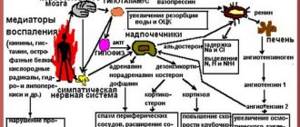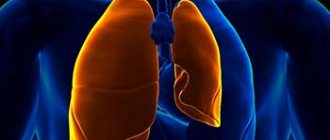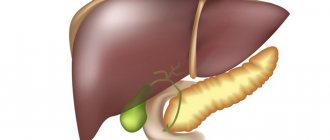Hepatic coma is a pathological condition that occurs due to a high concentration of toxic substances in the body and leads to complete inhibition of the central nervous system. As a rule, the prognosis in this case is disappointing, since this condition provokes internal bleeding. The pathogenesis of the disease indicates irreversible processes.
Stages of development and symptoms of hepatic coma
Despite the fact that hepatic coma that occurs with cirrhosis of the liver is an extreme degree of neglect of the disease, it also occurs in several stages, each of which is characterized by its own symptoms:
- precoma - nausea, loss of appetite, pain in the abdomen, impaired thinking and disorientation in space. Upon careful examination, a slight yellowing of the skin may be noted. A person can remain in this state from several weeks to several months;
- threatening coma is a stage of further development and aggravation of the disease. In addition to impaired thinking, difficulty speaking, tremors of the limbs, constant drowsiness and irritability are added, and loss of consciousness may occur. The yellowness of the skin of the entire body increases. In this state, in the absence of medical intervention, a person can remain for no more than 3–5 days. Your health suddenly deteriorates and medical attention is required;
- deep coma - characterized by the immersion of a person in an unconscious state. The body temperature remains high, muscle rigidity gradually worsens, although reflexes to strong stimuli still remain.
Knowing the symptoms of a developing coma with cirrhosis of the liver, it is important to record the appearance of the first of them and immediately contact specialists.
Early detection of signs of pathology increases the chances of recovery, while ignoring these symptoms often leads to rapid death.
Stages
They differ in their signs of the pathogenesis of the disease; there are only three stages, each of which has its own name, and differ in symptoms:
Prekoma
It manifests itself in sleep disturbances, deterioration of thinking, sudden and causeless mood swings, and it becomes difficult for the patient to navigate in space. The person experiences dizziness.
When talking, the patient seems to be reading a monologue; if he writes often, it will immediately be noticeable that his handwriting is deteriorating, and hand tremors are clearly visible. The stage can last from several hours to several months.
Symptoms of stage 1 hepatic coma (precoma) include:
- deterioration of general condition, accompanied by sleep disturbances (drowsiness during the day and insomnia at night);
- slow thinking;
- euphoria or lethargy, unmotivated behavior;
- hiccups and yawning;
- tachycardia;
- sweating
Variable symptoms may occur, including fever and bad breath (bad breath in hepatic coma is characteristically “liver-like”).
Some patients experience moderate jaundice, abdominal pain of varying intensity, hemorrhagic syndrome and disseminated intravascular coagulation syndrome, and may develop oliguria and azotemia, as well as infectious complications.
Threatened coma
All the signs that were observed during the first stage begin to appear more strongly. If he stretches his arms forward, then they will become cowardly, this phenomenon is called asterixis. The patient's memory deteriorates noticeably.
- severe disturbances of consciousness (loss of orientation in time and space, delirium), dizziness and fainting;
- slow speech;
- increasing weakness, adynamia;
- gait disturbances;
- periods of excitement that alternate with deep depression;
- drowsiness, negativism, memory loss;
- the presence of muscle tremors and “flapping” tremor of the hands.
As the pathological processes deepen, pathological reflexes and decerebrate rigidity are added, and convulsions are possible. A divergent strabismus may be observed while the pupillary reflexes are intact.
The stage can last several hours or 3 days, the most extreme period is 10 days.
Evolved form
The patient's face becomes mask-like, there is no consciousness, he reacts only to strong irritants, breathing becomes deeper, it is accompanied by noise, and a smell of bile reminiscent of ammonia is heard from the mouth.
Usually developed hepatic coma is accompanied by:
- lack of consciousness and reflexes observed in a normal state;
- muscle rigidity (neck and limb muscles), clonus of the foot muscles;
- the appearance of pathological reflexes (Zhukovsky, Babinsky, proboscis and grasping);
- periodic stereotypical movements;
- the presence of Kussmaul or Cheyne-Stokes breathing caused by hyperventilation;
- dilated pupils, lack of photoreaction and corneal reflexes;
- convulsions;
- sphincter paralysis;
- stopping breathing.
If timely first aid is not provided at this stage, respiratory arrest may occur and tonic convulsions may appear.
Causes of hepatic coma
Among the main conditions that cause the development of hepatic coma are:
- intoxication of the body due to excessive alcohol consumption or poisoning with heavy chemicals;
- some infectious or viral diseases, for example, hepatitis C;
- drug use or drug intoxication;
- the presence of benign or malignant formations in the liver area.
Doctors call another cause of hepatic coma a severe form of jaundice or complications after it. This cause is often observed in young patients under the age of 10 years.
Alcohol coma
In case of alcohol poisoning, primary coma is distinguished (develops in the first minutes or hours after drinking alcohol due to its narcotic effect) and secondary coma (develops at the height of exotoxic shock and multiple organ failure). There is not a single pathognomonic symptom of alcoholic coma!
A comatose state due to ethanol poisoning, like any other coma, can have 3 stages: superficial, deep, beyond.
All patients in alcoholic coma undergo: ECG examination (to exclude myocardial infarction and heart rhythm disturbances); glucometry (to exclude hypoglycemia and diabetic comas), thermometry.
Medical care for alcohol coma
To all patients:
- restoration of patency of the upper respiratory tract: evacuation of mucus and/or vomit from the oral cavity, for hypersalivation and bronchorrhea - atropine 0.1% 0.5 ml IV;
- oxygen therapy (oxygen 40-60 vol%);
- prevention of vomiting and regurgitation (giving the patient a stable lateral position, taking Sellica, metoclopramide (Cerucal) 0.5% 2-4 ml or ondansetron (Zofran) 0.2% 4 ml IV;
- ensure reliable venous access;
- warming the patient (if necessary);
- catheterization of the bladder (for acute urinary retention).
For superficial coma:
- tube gastric lavage (in a stable lateral position!) with warm water to clean lavage water with a total volume of 10-12 liters (the earliest possible tube gastric lavage is the most effective method of treatment!);
- detoxification therapy: dextran 40 (reopolyglucin) 400 ml or reamberin 1.5% 400 ml and/or polyionic solutions (Ringer's solution or its modifications) and glucose 5% IV in a total volume of at least 1000 ml;
- metabolic therapy: thiamine chloride (Vit. B1) 5% 2 ml IV, naloxone 0.04% 1 ml IV, sodium thiosulfate 30% 10 ml IV, cytoflavin 10 ml IV;
- for hypoglycemia - glucose 40% 60 ml (after preliminary administration of Vit. B1 5% 2 ml).
In deep and extreme coma:
- restoration of patency of the upper respiratory tract (use a Combitube tube or a laryngeal mask), if there is a threat of respiratory arrest - IVL, for apnea - IVL;
- tube gastric lavage (after tracheal intubation);
- detoxification and metabolic therapy, as in superficial coma;
- correction of hemodynamics: in case of collapse, mesaton 1% 1 ml as part of infusion solutions, to relieve cardiac arrhythmias - potassium-magnesium aspartate 250 ml i.v. slowly.
When consciousness is restored to moderate stupor, and other causes of coma are excluded, leave the patient at home under the supervision of relatives, if the patient lives alone - active after 2 hours.
In case of deep and extreme coma, all patients are subject to hospitalization.
For superficial coma:
- patients from public places who, after receiving assistance, cannot move independently are subject to hospitalization;
- patients from public places who, after receiving assistance, can move independently are transferred to police officers;
- sick people at home whose consciousness remains at the level of deep stupor, stupor or coma after assistance is provided must be transported to a hospital.
In case of refusal - an asset in a health care facility.
Types of hepatic coma
Doctors distinguish four types of hepatic coma depending on what diseases cause this pathology:
- endogenous - characterized by necrosis of hepatocytes in the liver and occurs against the background of diseases such as cirrhosis, hepatitis, poisoning with toxic substances;
- exogenous - develops against the background of cirrhosis complicated by hypertension;
- mixed - combines the first two types;
- false - characterized by a lack of potassium in the body against the background of developing cirrhosis of the liver.
The type of pathology can be identified based on test results. Diagnostics are carried out to determine the degree of neglect of the problem, as well as to determine the optimal methods of treating hepatic coma.
As a rule, a biochemical blood test allows you to see a complete clinical picture, on the basis of which conclusions can be drawn. In addition, ultrasound of the liver and abdominal organs, electroencephalogram, and MRI are also used.
Treatment
The causes of death in hepatic coma are severe poisoning, internal bleeding, cerebral edema, and pathology of the heart and blood vessels. Treatment started during “pre-coma” can be considered effective.
At this time, there are still no clear signs of liver problems, but an experienced doctor will be able to determine the future sharp deterioration of the patient’s condition. If there is a suspicion of coma, the patients are hospitalized in the department. In this case, the patient should be provided with complete rest; sedatives should not be used.
In the emergency department of a hospital, a patient may be given:
- isotonic sodium chloride solution,
- 5% glucose solution,
- hemodesis.
These drugs are part of detoxification therapy; recommendations for their use are issued by a doctor. In a hospital setting, the patient is provided with maximum rest, given laxatives, and cleansing enemas twice a day. Some patients are injected with a special synthetic substance - lactulose, which enters the large intestine and breaks down into lactic, formic and acetic acids.
The main task of the doctor is to cleanse the body of excess nitrogen and ammonia, which is possible by changing the bacterial intestinal microflora in favor of bacteria that do not produce nitrogen. Methods and types of treatment depend on the individual characteristics of patients.
Lactulose is taken orally 15-45 ml up to 4 times a day, but only if the patient does not have intestinal obstruction and does not develop negative reactions characteristic of other disease syndromes. Side effects from taking it include excess sodium and diarrhea. The drug is also prescribed in the form of enemas. The form of treatment depends on physiology.
The antibiotic Neomycin is no less effective in treating hepatic coma. The drug suppresses the production of ammonia; it is prescribed orally. All patients, without exception, are prescribed maintenance vitamin therapy and placed on IVs.
It is important to understand that the sooner the patient arrives at the hospital, the greater his chances of life , so trying to cope with the signs of liver failure is very dangerous. A person who has fallen into a coma completely loses consciousness, the pupils stop responding to stimuli, dilate, the corneal and swallowing reflex are impaired, and at this stage he does not feel pain.
The final stage is death. Hepatic coma is especially dangerous in children. Getting a small child to talk about his problem is very difficult. The child is first interviewed and only after that some research is carried out, which helps him calm down a little.
First aid for hepatic coma
Pathology can be treated only in a medical institution under the supervision and control of qualified doctors. Timely contact with a specialist increases the chances of preserving the life and health of the patient.
Having noticed the first signs of the development of hepatic coma, it is important to immediately call emergency doctors, and before they arrive, provide the person with pre-medical care. The most effective actions are the following steps:
- lay him on his side and ensure sufficient oxygen supply;
- if vomiting occurs, ensure that the vomit does not remain in the mouth or enter the respiratory tract;
- give as much fluid as possible to drink;
- try to calm down and reduce increased excitability;
- When a disorder of thinking and behavior manifests itself, make sure that the person does not injure himself.
It is important to record the time when symptoms of hepatic coma began to appear. In addition, to correctly understand the clinical picture, the specialist will need to know how the attack manifested itself and how the signs of pathology grew.
It is absolutely impossible to treat hepatic coma at home or hope that the problem will go away on its own. The onset of the second and third stages of this condition in 85% of cases ends in immediate death, so a person’s life depends on the speed of reaction and the effectiveness of the therapy used.
Diagnosis
Recognition of hepatic coma is based on the presence of jaundice and damage to the central nervous system. Under artificial light, jaundice can be overlooked. If hepatic coma develops at the beginning of infectious hepatitis, then jaundice, as already indicated, may be mild and therefore examination of urine and feces is necessary. In such cases, urine is intensely colored with bile pigments and has the color of beer. Sometimes yellow spots (traces of urine containing bilirubin) can be seen on the underwear of patients. The stool is discolored. It is very important to promptly detect the precursors of a coma: weakness, drowsiness, apathy and adynamia. If appropriate treatment measures are not carried out in a timely manner, then severe neuro-cerebral symptoms develop, foreshadowing an imminent deep coma and the death of the patient. The appearance of signs of hemorrhagic diathesis (bleeding gums, bruises on the skin) should be regarded as a consequence of a serious illness. Pregnant women with infectious hepatitis, in whom Botkin's disease is usually severe, require special attention. Caution should also be exercised in relation to patients in whom infectious hepatitis has taken a protracted course.
Features of the treatment of hepatic coma
The main direction of treatment of the pathological condition is the use of drug therapy. Medicines are divided into several main groups depending on their purpose.
- First of all, the body must be cleansed of toxins and toxic substances. To cleanse the intestines, enemas or laxatives are used, and a solution of glucose, vitamins and lipoic acid is injected intravenously into the patient.
- Antibacterial medications also help prevent the buildup of toxins in the body.
- Antibiotics prevent the occurrence of infectious complications.
- To stop necrotic processes in liver cells, Prednisolone is used.
- To replenish the amount of electrolytes in the blood, ready-made solutions such as Disol, Trisol and Ringer's solution are used.
- An important factor in the treatment process is diet, if the patient can eat on his own. The diet is set in such a way as to exclude foods that contribute to the formation of ammonia in the body. If the patient is in a coma and is unable to eat, a glucose solution is infused intravenously with the addition of the required amount of insulin.
The most effective treatment method, which increases the likelihood of recovery and leading a normal lifestyle in the future, is a healthy liver transplant. The operation is a complex surgical procedure and requires careful preparation. In this case, the patient's condition must be stable.
Live healthy! New methods of treating liver cirrhosis (12/11/2017)
Hepatic coma is a complex and intractable condition that occurs as a result of the development of cirrhosis of the liver. The prognosis and effectiveness of treatment directly depend on the speed of seeking medical help. In the early stages, the pathology can be recognized and stopped, thereby saving the patient’s life.
Emergency care for hepatic coma: how to treat and what to do at home
Hepatic coma is the most severe stage of hepatic encephalopathy.
Developing against the background of liver destruction and the resulting disruption of the basic functions of the organ, coma is often considered a hopeless condition that ends in the death of the patient. Emergency care for hepatic coma is the only measure of salvation. Most patients suffering from one or another liver disease in its progressive form more than once encounter a similar phenomenon, therefore it is important for close relatives, and just people around them, to know everything about how to help such a patient before the doctors arrive.
Coma is one of the most serious pathological conditions.
Causes
Liver failure and subsequently coma occur due to the development of acute and chronic diseases of the internal organs. The pathogenesis and etiology of the disease have been well studied and have a consistent algorithm. In particular, one of the main causes of the disease in question is viral hepatitis .
The liver also suffers as a result of severe toxic damage:
- poisoning with toxic chemicals, gases,
- alcohol poisoning,
- intoxication of the body due to consumption of poor quality food.
In some cases, liver failure is caused by medications taken, to which the patient has developed an allergic reaction that had not previously manifested itself.
During acute liver failure, the nerve endings are primarily affected. The developing disease causes headaches, the person loses consciousness and becomes delirious. The liver temporarily loses its ability to neutralize toxic products that enter the body from the external environment and are formed as a result of metabolism.
If the liver disease is chronic, then a small part of the blood can get from the portal vein into the cava, this aggravates the intoxication and, accordingly, prevents the patient from being brought out of the coma.
A healthy liver copes well with most poisons. For example, ammonia coming from the portal vein is converted into urea, which is removed from the body during urination. A diseased liver does not perform this function, which leads to the accumulation of large amounts of this toxic substance in the body.
In hepatic coma, the body poisons itself , with the central nervous system becoming the first organ affected. Hepatic coma also develops in pregnant women at 1 and 2 weeks of pregnancy, who were previously treated for serious concomitant diseases, such as hepatitis of various forms.
With cirrhosis of the liver, coma can occur after exceeding the dose of alcohol consumed, hypokalemia, infection, taking hepatoxic drugs and exacerbation of hepatitis.
If a patient has a stomach ulcer and internal bleeding has developed, this can complicate the existing cirrhosis of the liver; blood entering the intestines becomes a source of ammonium, which further disrupts nitrogen metabolism and leads to coma. Classification of the disease is difficult.
Symptoms
The clinical picture and symptoms of hepatic coma are the same and do not depend on the causes that provoked the development of the disease or its form. the main symptoms appear gradually, most often from the central nervous system. Patients complain of:
- severe and sharp headache,
- drowsiness during the daytime,
- apathy towards everything that happens,
- insomnia at night,
- general weakness, which increases every day.
Sometimes bitterness occurs in the mouth, taste buds stop working as usual, which is why the usual food seems tasteless, appetite disappears, and the person constantly feels sick.
If the symptoms described above are not paid attention to, the intoxication of the body worsens, which manifests itself in the form of:
- spatial orientation disorders,
- confusion of thoughts, a person ceases to understand what is happening to him, loses the essence of the conversation,
- delirium,
- psychomotor agitation (the patient wants to constantly move and do something, but since his coordination is already impaired by this time, it is difficult to perform such actions),
- uremia,
- epilepsy seizures of varying severity.
Upon examination by a neurologist, the patient exhibits increased reflexes in the tendon area, Babinski's sign (bilateral), and less commonly, meningeal signs. The hands, but even the facial muscles, tremble, and convulsions are observed.
As the condition worsens and the patient approaches falling into a coma, the tendon reflex disappears, the pupils dilate and become motionless, the mental state returns to normal, which gives false hope for a speedy recovery. Epileptic seizures may persist, and sometimes convulsive muscle contractions also persist.
Important! A specific sign of liver failure, and subsequently coma, is musty breath. The patient's urine and sweat gland secretions also smell unpleasant.
The precursor to hepatic coma is jaundice without its characteristic skin itching. The tongue turns red, and the characteristic white coating disappears. The patient's abdomen is swollen, he hiccups, and experiences constant vomiting. Uterine and intestinal bleeding, rashes on the mucous membranes of the mouth and genitals are possible. The temperature rises, hyperthermia is observed.
Forms
The pathophysiology of hepatic coma is represented by the following forms:
- shunt hepatic coma,
- spontaneous coma,
- mixed coma,
- uremic coma,
- false coma.
The pathophysiological features of the development of coma have not been sufficiently studied.
Signs of coma are also associated with alcoholic liver disease, which has ICD 10 code K70. The international classification of this type of coma may differ slightly from the domestic one, but in the process of providing first aid, attention is also paid to removing alcohol from the body.
Urgent Care
If signs of illness are found at home, and the ambulance is moving slowly, then the patient must be forced to drink as much sweetened water or tea as possible.
If a person’s behavior becomes inappropriate, then you can give a sedative, or try to keep him in one place until the doctors arrive (tie him with sheets to the bed, arrange something in a straitjacket), coma develops as a result of serious complications, therefore you cannot hesitate to call a doctor, this condition requires emergency care. If vomiting occurs, access to a toilet and fresh water should be provided.
The more water the patient drinks, the faster his stomach will be cleared, toxins will be eliminated, which means the load on the liver will be reduced, and the risk of death of the disease will decrease.
If the patient is very excited, then if you have ampoules with diphenhydramine in your home medicine cabinet, you need to give an intramuscular injection (2 ml of a 1% solution of the substance). If vascular insufficiency is observed, 2 ml of cardamine and 1 ml of 1% mesatone solution are injected intramuscularly.
Unfortunately, treatment started after the appearance of obvious signs of liver failure rarely brings positive results.
Only 20% of patients survive, therefore, at the slightest suspicion of liver problems in a person who previously suffered from it, it is necessary to call an ambulance or go to a medical facility on your own. Every minute counts, so you shouldn’t wait for medical help at home.
Diagnostics
Often patients come to the doctor with completely different complaints. Without a medical education, it is quite difficult to determine what exactly and where it hurts. The doctor is interested, first of all, in the history of the diseases that the patient has previously encountered.
So, if liver failure and possible coma are suspected, the patient is immediately admitted to a hospital and blood is drawn to determine the level of bilirubin (hyperbilirubinemia, or increased bilirubin levels, is the main sign of coma). Bilirubin diagnosis is the basis for such a disease as “hepatic coma”.
Liver function tests are also positive. The urine darkens, becomes almost orange-brown, and protein, bilirubin, urobilin, and bile acids are found in it. The stool is colorless and the test for stercobilin is positive.
Treatment
The causes of death in hepatic coma are severe poisoning, internal bleeding, cerebral edema, and pathology of the heart and blood vessels. Treatment started during “pre-coma” can be considered effective.
At this time, there are still no clear signs of liver problems, but an experienced doctor will be able to determine the future sharp deterioration of the patient’s condition. If there is a suspicion of coma, the patients are hospitalized in the department. In this case, the patient should be provided with complete rest; sedatives should not be used.
In the emergency department of a hospital, a patient may be given:
- isotonic sodium chloride solution,
- 5% glucose solution,
- hemodesis.
These drugs are part of detoxification therapy; recommendations for their use are issued by a doctor.
In a hospital setting, the patient is provided with maximum rest, given laxatives, and cleansing enemas twice a day.
Some patients are injected with a special synthetic substance - lactulose, which enters the large intestine and breaks down into lactic, formic and acetic acids.
The main task of the doctor is to cleanse the body of excess nitrogen and ammonia, which is possible by changing the bacterial intestinal microflora in favor of bacteria that do not produce nitrogen. Methods and types of treatment depend on the individual characteristics of patients.
Lactulose is taken orally 15-45 ml up to 4 times a day, but only if the patient does not have intestinal obstruction and does not develop negative reactions characteristic of other disease syndromes. Side effects from taking it include excess sodium and diarrhea. The drug is also prescribed in the form of enemas. The form of treatment depends on physiology.
The antibiotic Neomycin is no less effective in treating hepatic coma. The drug suppresses the production of ammonia; it is prescribed orally. All patients, without exception, are prescribed maintenance vitamin therapy and placed on IVs.
It is important to understand that the sooner the patient arrives at the hospital, the greater his chances of life , so trying to cope with the signs of liver failure is very dangerous. A person who has fallen into a coma completely loses consciousness, the pupils stop responding to stimuli, dilate, the corneal and swallowing reflex are impaired, and at this stage he does not feel pain.
The final stage is death. Hepatic coma is especially dangerous in children. Getting a small child to talk about his problem is very difficult. The child is first interviewed and only after that some research is carried out, which helps him calm down a little.
Hepatic encephalopathy.
Loading…
Source: https://KardioBit.ru/bolezni-pecheni/pechyonochnaya-koma-pervaya-pomoshh-simptomy-lechenie
Diagnostic and laboratory confirmation of hepatic coma
- First of all, they collect an anamnesis of life and illness, find out the disease with chronic liver diseases (especially cirrhosis of the liver). If the patient is busy. According to relatives and medical documentation. Find out the drugs. What did the person take before illness? When did you notice the problem? Where did you go?
- Skin color, presence of bruises, and spider veins are objectively assessed. Examine the oral mucosa, its color, and tongue. Measuring the volume of the abdomen to determine ascites. Pay attention to the presence of edema. Manifestations of mental and consciousness disorders are assessed.
- Routine blood and urine tests are taken.
- Mandatory blood biochemistry sampling (bilirubin and its parts, glucose, amylase, urea, creatinine, protein and its parts, ALT, AST, alkaline phosphatase, GGT, bicarbonates, potassium, magnesium, calcium, chlorides, lipase level in liver cirrhosis).
- Coagulogram (fibrinogen, prothrombin time). Detection of hemorrhagic syndrome.
- Blood serology (to clarify or exclude viral hepatitis).
- Detection of autoimmune liver damage (immunoglobulin levels, ANA, SMA).
- Determination of ceruloplasmin (copper-containing protein) to exclude Wilson-Konovalov disease.
- Determination of acitamenophen in the blood to exclude an overdose of paracetamol.
- Determination of lactate and ammonia to establish intoxication.
- Clarification of blood type and Rh, in case of blood loss or surgery.
- Pregnancy test or objective confirmation of pregnancy. To exclude acute fatty hepatosis.
- Blood tests for medications if suicide is suspected.
- MRI, CT, ultrasound.
- Other laboratory tests and investigations may be required on a case-by-case basis.
The diagnosis of hepatic coma can be established or refuted by daily monitoring, over time, of changes in laboratory tests:
- Decrease in prothrombin index, proconvertin and accelerin.
- In biochemistry, a decrease in cholinesterase, cholesterol, fibrinogen, and albumin levels.
- A carbohydrate metabolism disorder occurs in the form of a decrease in blood glucose.
- A rise in blood lactate is detected. Which is a signal of an unfavorable outcome.
- Bilirubinemia in the blood, from obvious to slight, reflects the intensity of jaundice.
- The level of ammonia in the blood increases over time.
- In a comatose patient, there is an increase in the level of amino acids (tyrosine, methionine, tryptophan, phenylalanine) in the blood.
- Other indicators in blood serum have individual significance.
Liver cell failure
Hepatic-cellular failure (synonyms true, endogenous) with a rapid onset and rapid development of coma and death. Presented by:
- Alcoholic hepatitis,
- Acute fatty hepatosis of pregnant women,
- Paracetamol overdose,
- Acute hepatitis of viral etiology (-A, -B, -C, -D, -E),
- Carrying out anesthesia with fluorotane for the second time.
The main role is a sharp decline in the mass of active cells and the development of hepatocyte necrosis. With a slow course, the previous mechanism is supplemented by a disruption of clotting and the involvement of a bacterial infection.
Portal-hepatic failure (synonyms vascular, exogenous coma) is encountered in liver cirrhosis. Characterized by a slow course, this type of coma is better treated.
Lightning form. There was no prior, chronic illness in its formation. Failure increases quickly, rapidly, in the presence of an acute disease, in a short time from the onset of the disease.
Extensive, powerful liver necrosis occurs and leads to hepatocellular coma. Coma develops to a severe stage, very quickly and can be fatal.
This form occurs when:
- acute drug-induced hepatitis,
- poisoning by poisonous and toxic agents,
- acute viral hepatitis,
- fatty hepatosis in pregnant women and others.
We meet the chronic form:
- For liver tumors,
- with cirrhosis of the liver,
- for chronic hepatitis and other reasons.
Many months or years pass before the onset of liver failure. More often, portal-hepatic failure is detected, less often hepatic-cellular failure, sometimes a combination of both. The decline in the number of active cells does not happen quickly or bypass paths develop (anastomoses, shunts). Coma has a special course with alternating exacerbations and remissions, a gradual increase in symptoms.
Exacerbation of chronic liver failure is noted:
- For chronic alcoholic hepatitis,
- With cirrhosis of the liver,
- For liver tumors and other reasons.
Both types of liver failure are combined. The coma unfolds and grows rapidly. Complications of a chronic disease can be caused by:
- Septic conditions,
- Overdose of medications (diuretics and others),
- Intestinal or stomach bleeding
- Surgical intervention,
- Drinking alcohol in significant quantities,
- Vascular event and others.
- Combined forms of liver failure:
- Traumatic event
- The burns are large,
- Failure "shock liver"
- Myocardial infarction or stroke,
- Failure of the "septic liver"
- Liver failure in combination with renal failure.
- Liver failure in combination with renal and pancreatic failure.
- In combination with electrolyte deficiency.
- Unidentified liver failure.
The leading sign of liver failure is coma. In the process of coma, precoma and 3 stages are defined:
- In precoma, mental abnormalities predominate, consciousness is not lost, reflexes are preserved.
- In coma 1, wave-like depression of consciousness prevails; in episodes of restoration of consciousness, mental disorders predominate, reflexes are preserved.
- In coma 2, the unconscious status is continuous, reflexes are preserved.
- In coma 3, there is a continuous state of unconsciousness and there are no reflexes.
Treatment is effective in precoma and coma 1, ineffective in coma 2 and ineffective in coma 3.
Possible reasons
Hepatic encephalopathy occurs as a result of the accumulation of toxic substances in the body. The following reasons may lead to this:
- external toxic factors, for example, poisoning with phosphorus, arsenic, mushrooms and alcohol,
- taking drugs that have a hepatotoxic effect on the liver: Atophan, Paracetamol, barbiturates, etc.,
- diseases of the gastrointestinal tract that cause degeneration of the liver parenchyma, such as cirrhosis, cholestasis, oncology, etc.
- negative effects of viruses: hepatitis B and A, infectious mononucleosis and yellow fever virus,
- serious stressful situations, for example, large area burns, septic abortions, etc.
Depending on the factors provoking the pathology, doctors distinguish several types of hepatic coma:
- Endogenous hepatic coma. Destruction of liver cellular structures and necrosis are observed. As a result, the organ stops working and cannot cope with its functions, provoking the accumulation of toxic substances in the body.
- Exogenous hepatic coma. Typical for patients with liver cirrhosis or bleeding in the digestive tract,
- Mixed type. Develops with necrosis of some liver cells and with the intake of ammonia during cirrhosis,
- Mineral type. Characterized by electrolyte imbalance and hypokalemia.










